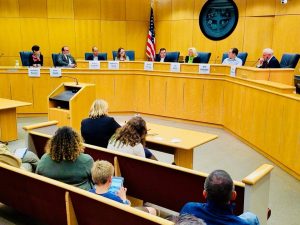
by Cindy
Last night, Delegate Jennifer Boysko (D-86) held a town hall in Herndon to discuss “the future of energy in Virginia” (see video at the bottom of this post). The panel speakers were Hayes Framme from Ørsted (Danish offshore wind company that is partnering with Dominion on a pilot offshore wind project in Virginia), Katharine Bond from Dominion Energy, Scott Emery from Zero Carbon Virginia, Ivy Main from the Sierra Club, Will Gathright from Tumalow (energy storage startup company), and Eric Holdsworth from Edison Electric Institute (the main association of investor-owned electric companies has fought hard nationally against net metered solar – and whose chairman denied the science of human-caused global warming in March of 2017). The discussion was moderated by Flint Webb from the Air and Waste Management Association; which is a nonprofit, nonpartisan organization that provides “a neutral forum for exchanging information” (I suspect this is a euphemism for environmental “bothsides-ism,” but I’m not sure.)
Before I get to the details of the event, I can’t ignore a couple of elephants in the room. I’m so sorry, Katharine Bond of Dominion, you’re perfectly lovely and I don’t mean to call you an elephant, but inviting a Dominion lobbyist (and others who don’t have a clean environment as their number one objective) to a discussion of why Virginia is moving so slowly towards renewables, efficiency and clean energy made for a certain awkwardness, since everyone in the room was aware that Dominion’s objectives do not align with the environmentalists’-–unless the legislature or regulatory agency forces them to be.
The other elephant in the room is about 42” wide and tromps through some of the most beautiful land, forests, and family homes and farms in all of Virginia. It was made clear from the minute the town hall was announced that this was NOT to be a discussion about the pipelines. Given the current frustrations that environmentalists feel about the continued construction on the MVP and ACP despite the damage they’re doing, the hazards they pose to the residents and to the environment, and their needlessness, discussing Virginia’s energy future without mentioning the pipelines was like cleaning a window with a muddy rag. At the request of pipeline activists, Delegate Boysko did allow a table to be set up outside the room with information about the pipelines, and that helped appease the crowd, but did not change that it is ridiculous to discuss renewables investments while ignoring the continued investment in fracked gas pipelines.
Despite these drawbacks, there was some good discussion. The consensus: Virginia has enormous potential to transition to 100% renewables or zero carbon by 2035, through some combination of utility-scale solar, consumer-owned (distributed) solar, offshore wind, efficiency improvements, storage technologies, and carbon-free technologies. But we are not currently pursuing ANY of these with sufficient urgency because legislators and regulators are not mandating it.
A few points made on each of these:
- Utility-scale solar has the advantage of equity—it brings renewable energy to all communities, not just those who can put panels on their rooftops. The obstacles however are many. Such projects have struggled to obtain regulatory approval, since our regulatory agency, the SCC, mainly prioritizes costs without regard to long term environmental goals. Additionally, utility-scale solar requires considerable land, both for the solar farm itself, as well as the path the energy must travel from the farm to the nearest load center. This is both expensive and requires considerable permitting. Lastly, utility-scale solar requires convincing local residents that it’s safe and that tolerating the look is worthwhile.
- Distributed solar avoids many of these problems. It does not require new land, as solar panels can be placed on existing private and government buildings, other open spaces, and even landfills. NREL estimates that 38% of our total energy needs could be met with rooftop solar. The obstacles here are primarily legislative—our current laws on net metered solar place a host of arbitrary restrictions on the ways in which ordinary residents and business-owners are blocked from using solar as much as they want and in whatever ways they want. There are idle concerns about the grid not being modern enough to handle large amounts of two-way meter flow, but we are NOWHERE near that amount, and current legislation caps distributed solar projects well below what experts say our grid can handle before modernization.
- Offshore wind is a great opportunity in Virginia—Virginia has enough offshore wind energy potential to run its entire economy. And the technology improvements here are stunning: one wind turbine built today generates in 18 days what the entire first-ever wind farm did in a year. Unlike onshore wind, it’s mostly out of sight, and it’s far enough offshore that it doesn’t affect migratory bird and bat populations. The only obstacles (other than regulatory approval) are that turbine construction must be mindful of the fishing industry and of military water uses, and that the federal government owns the sea floor out to 200 miles. Only one area on Virginia’s coast is currently permitted to build wind turbines, the (113,000 acre) space leased for the Dominion-Ørsted project.
- Obviously the cheapest form of energy is that energy you don’t use—the energy that you conserve by being more efficient, by building homes and buildings that are more energy-efficient, by developing energy-efficient transportation alternatives. The obstacles her too are mainly regulatory (the SCC finding efficiency programs too costly to consumers, not taking into account the environmental benefits) and legislative (not mandating that the utilities find and adopt efficiency programs).
- Our neighbors in Maryland have a $1 billion dollar energy efficiency program funded by the state, in part using emission credits auctioned in RGGI. They used that to set and meet a 2015 goal for 15% energy reduction, and have since mandated a 2% per year additional rate of energy use reduction. For every $1 spent on this program, consumers save $1.80. And it’s an enormous job creator.
- There are other options for reducing carbon other than (in addition to) renewables that may be technologically feasible in the near future: this includes dispatchable (can be turned on and off at will) zero-carbon energy sources, such as advanced nuclear and carbon capture (fossil fuels, but using technology to keep them from emitting carbon) technologies. Additionally, technologies that allow us to store renewable energy need to improve. These feel like the problems we face in getting from perhaps 50% renewables all the way to 100%, but less concerning right now when we’re at less than 3%.
- One obvious solution is a mandatory renewable portfolio standard (RPS) that sets a mandatory goal for percent of energy coming from renewables. Virginia currently has a toothless, weak, voluntary standard. 29 states have a mandatory RPS, which allows them to tap into a different renewables mix, and avoids locking into today’s technology. Mandatory RPS have been proven effective all over the country.
At one point Delegate Boysko asked “So, what’s stopping us?” There was awkward laughter in the room, because frankly, it’s primarily the legislature that’s stopping us. Utility companies aren’t going to just decide on their own to abandon the huge natural gas and investments they’ve made over the last fifty years and adopt renewables. They’re not going to voluntarily reduce demand for their own product by pushing distributed solar and efficiency programs. And even if they did, the regulatory structure isn’t conducive to approving such changes.
The 2018 Grid Transformation And Security Act was a tiny baby step in the right direction—at a time when we need to be sprinting. And, it was noted by one panelist that the approach was still “what are the utility companies willing to do,” rather than “what should the legislature mandate be done?”
We have to rethink how we regulate the utility industry. Dominion’s objectives are to 1) meet supply, 2) comply with regulations, 3) at the lowest cost. Their shareholders demand low-risk and maximum profits. Unless we want to wait for it to be in their shareholders’ interest to transition to 100% renewables, we will have to change the regulatory system and incentives so that they are required to.



 Sign up for the Blue Virginia weekly newsletter
Sign up for the Blue Virginia weekly newsletter
![Friday News: “Ukraine accuses Russia of undermining peace talks with new demands”; “Trump’s Bromance With Arab Leaders”; “The Day Grok Told Everyone about [100% false] ‘White Genocide’”; Trump’s 2024 Senior Strategist Calls Earle-Sears’ Campaign “Amateurs”](https://bluevirginia.us/wp-content/uploads/2025/05/montage0516-238x178.jpg)






